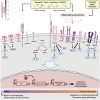Hematopoietic stem cell a reservoir of innate immune memory
- PMID: 39720722
- PMCID: PMC11666435
- DOI: 10.3389/fimmu.2024.1491729
Hematopoietic stem cell a reservoir of innate immune memory
Abstract
Hematopoietic stem cells (HSCs) are a rare, long-lived and multipotent population that give rise to majority of blood cells and some tissue-resident immune cells. There is growing evidence that inflammatory stimuli can trigger persistent reprogramming in HSCs that enhances or inhibits the cellular functions of these HSCs and their progeny in response to subsequent infections. This newly discovered property makes HSCs a reservoir for innate immune memory. The molecular mechanisms underlying innate immune memory in HSCs are similar to those observed in innate immune cells, although their full elucidation is still pending. In this review, we examine the current state of knowledge on how an inflammatory response leads to reprogramming of HSCs. Understanding the full spectrum of consequences of reshaping early hematopoiesis is critical for assessing the potential benefits and risks under physiological and pathological conditions.
Keywords: emergency hematopoiesis; epigenetic; hematopoietic stem and progenitor cells (HSPCs); inflammation; innate immune memory; metabolism; myelopoiesis.
Copyright © 2024 Ruffinatto, Groult, Iacono, Sarrazin and de Laval.
Conflict of interest statement
The authors declare that the research was conducted in the absence of any commercial or financial relationships that could be construed as a potential conflict of interest.
Figures




Similar articles
-
Hematopoietic stem cell state and fate in trained immunity.Cell Commun Signal. 2025 Apr 14;23(1):182. doi: 10.1186/s12964-025-02192-1. Cell Commun Signal. 2025. PMID: 40229653 Free PMC article. Review.
-
The potency of hematopoietic stem cell reprogramming for changing immune tone.Immunol Rev. 2024 May;323(1):197-208. doi: 10.1111/imr.13335. Epub 2024 Apr 17. Immunol Rev. 2024. PMID: 38632868 Review.
-
Discovering adaptive features of innate immune memory.Immunol Rev. 2024 May;323(1):186-196. doi: 10.1111/imr.13328. Epub 2024 Apr 2. Immunol Rev. 2024. PMID: 38563500 Review.
-
Hematopoietic stem and progenitor cells fine-tuning the "sweet" of trained immunity.J Leukoc Biol. 2025 May 7;117(5):qiaf043. doi: 10.1093/jleuko/qiaf043. J Leukoc Biol. 2025. PMID: 40233187 Review.
-
Trained Immunity and Cardiometabolic Disease: The Role of Bone Marrow.Arterioscler Thromb Vasc Biol. 2021 Jan;41(1):48-54. doi: 10.1161/ATVBAHA.120.314215. Epub 2020 Nov 19. Arterioscler Thromb Vasc Biol. 2021. PMID: 33207931 Free PMC article. Review.
Cited by
-
Quiescence Multiverse.Biomolecules. 2025 Jul 4;15(7):960. doi: 10.3390/biom15070960. Biomolecules. 2025. PMID: 40723832 Free PMC article. Review.
References
Publication types
MeSH terms
LinkOut - more resources
Full Text Sources
Medical

